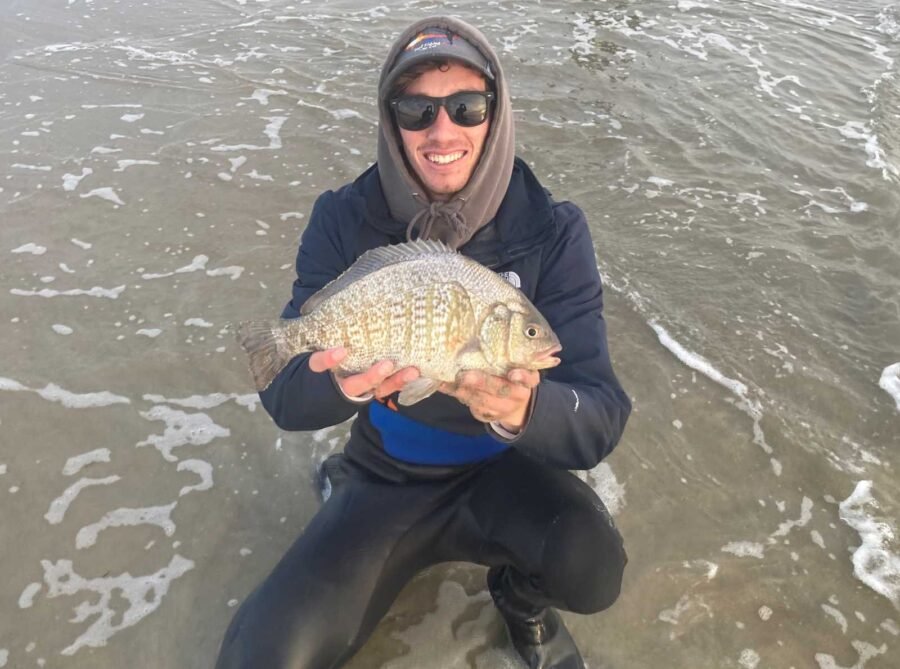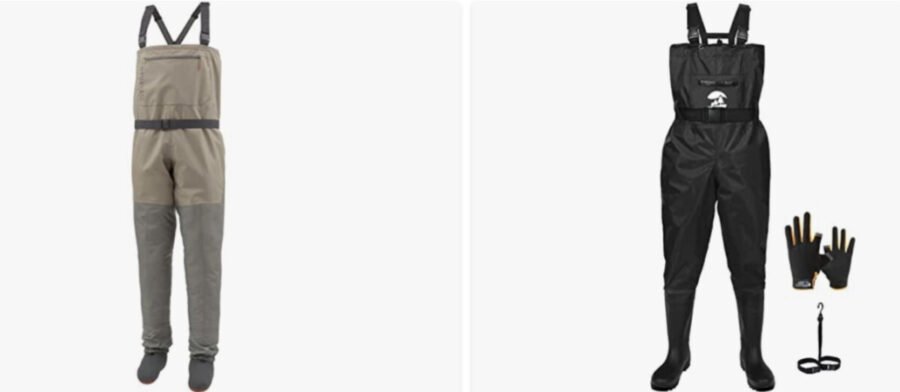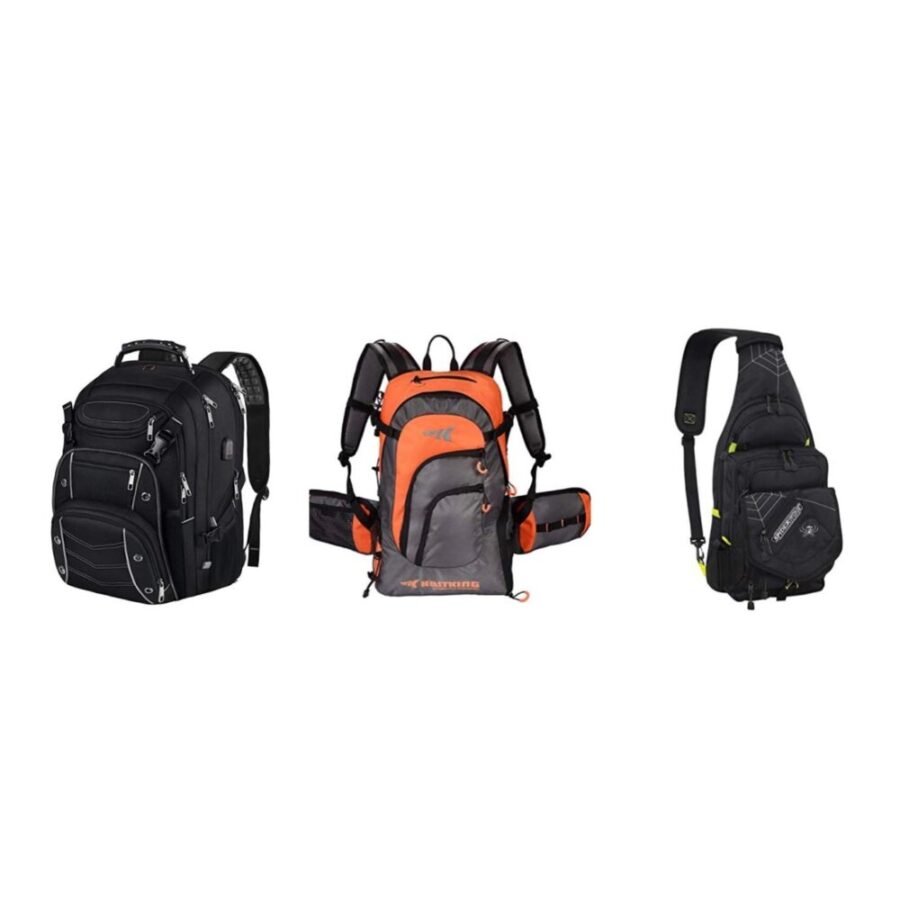5 Tips for Surfperch Fishing in the Fall and Winter

So it’s fall. The mornings and nights are chilly, the water temps are beginning to dip, and the fish… well, they aren’t biting like they did in the summertime. While summer is king, fall and winter surf fishing really isn’t as unproductive as everyone makes it out to be. If you know what you’re doing and use the right baits and tactics, you can certainly still have 10, even 20+ fish days. Corbina and croaker may slow, but surfperch fishing in the fall and winter is actually better than summer!
Not only that, surfperch are commonly caught by most anglers in the 7-inch to 11-inch range, but by fishing the right types of structure and using the right baits, you can catch much larger surfperch on a regular basis.
Before I go on, I want to call your attention to my article on “Surfperch Fishing: Everything You Need to Know“. The best way to describe that article is a culmination-overview of everything I’ve learned over the years.
Best Baits for Surf Perch
The first thing we’ll cover is the topic of the best baits for surfperch. In the summertime, you can catch sand crabs easily and use them for bait to catch just about everything in the surf zone. In the fall and winter time, sand crabs aren’t an option. So we need to use alternative bait options when we’re surfperch fishing in the fall and winter.
The best baits for surfperch fishing are as follows:
- Mussel Meat
- Jerkbaits
- Gulp sand worms
- Honey Badger Baits (soft plastics)
Surfperch Fishing with Mussel Meat

I’ve used mussel meat as my primary bait for surf fishing in the fall and winter for the past three or four years and when it comes to bait… it’s number 1. It’s tough to get used to as it can be delicate, but it produces similarly to sand crabs in the summertime, and surfperch absolutely love them!
For a complete run down of how I surf fish using mussels for bait, read the linked article. I’ll go over what kind of mussel meat I use, where I get it, how to hook it, and how I fish with it.
Catching Surfperch on Jerkbaits
This is an interesting one that is more commonly practiced up in Central California and Northern California. But, to catch the biggest surfperch, your best bet is using jerkbaits like the Lucky Craft FM 110. It’s not that simple though.
Lure fishing in the surf takes time, and it also requires that you find the right structure to fish. In my experience, you need to find the right structure, in the right conditions, at the right time. So what is all that? We’ll talk more about it as we continue in this article, but it involves hard structure near sandy areas and timing your sessions during their mating season and spawning season… among other things.
Gulp and Honey Badger Baits
I don’t use either of these very frequently, but I have used them and still keep them on me as back up options. They both work undeniably well, but I don’t think they work as well as mussel meat. I also think you tend to catch smaller fish, in general on these small, soft plastic artificials.
Fishing the Surfperch Spawn
I wrote an article last year on surfperch breeding and aggression and why the surfperch spawn is important to both surfperch fishing and halibut fishing and briefly mentioned the following.
Surfperch have a gestational period of 5-6 months. This period begins with mating in the fall (usually November) and finishes with birthing in the spring (usually April). From November-January, I typically stick with mussel meat as my bait of choice. They begin to feed more actively in the fall, but their diet changes through winter and into spring. This means when your surfperch fishing in the fall and winter, using bait is best, but for late winter through spring, continue reading.
From February-May, I like to use the jerkbait mentioned above. My reasoning is that as these fish progress further in their gestational period, they need more energy to sustain the many live young inside of them (usually around 20-40 fry but as many as 100 at times). So, they resort to feeding on bigger prey like sardines, anchovy, and other small bait fish. I believe surfperch often feed on freshly born surfperch at times as well, and I know for a fact, halibut gorge on these newborn surfperch during the spawn. Halibut as bycatch sounds pretty sweet, huh?
Structure and Tides
The right structure is exactly what I mentioned earlier: sandy areas with mixed hard structure. My favorite areas are 95% sand but with a couple dense areas of rocks or other hard structure that allows for mussels and other marine life to grow off of. Too much structure and it’ll draw in all the big game predators like seabass, calico, and rockfish. But, just a small amount allows for good ambush spots and tons of bait for them to live off of without attracting many big predators.
As for the tides, it’s more about fishing the right tidal height for your specific fishing spot than it is about a rising or falling tide. For example, if I like a spot where the hard structure is properly submerged and within casting distance at tidal heights of between 2 and 4 feet, I’ll fish it when it aligns accordingly, whether it’s rising or falling. If I had to pick between a rising tide and a falling tide, I guess I’d pick rising, but it doesn’t mean a ton to me. To check the tides, visit surfline.com.
Time of Day
Time of day is an interesting one. Personally, come the fall and winter time, I leave time of day as the last factor I’ll look at after lining everything up with the right spot/structure and the tides. But, in my experience, late-morning (9am-11am) has been the best time of day for surfperch fishing.
Sometimes the bite is on right at the crack of dawn, but it’s not the end of the world if you can’t get up in time for the “first light bite”. Often, it’s better later in the morning. I typically see early morning as a 50/50 chance that the bite is on, late morning as your best bet, and then evenings as hit or miss when it comes to surfperch specifically. But, yellowfin croaker will turn on year round in the evenings with sunset slots.
Gear
- Rod: Okuma Celilo (8’6″ MA) or the Okuma SST (8’6″ MA)
- Reel: Penn Battle II or III 4000 series
- Mainline: 15-pound monofilament
- For Bait: Carolina Rig:
- Leader Line: 15-pound fluorocarbon
- Swivels: 15-19mm barrel swivels
- Hooks: size #2 or #4 owner mosquito hooks
- Weights: 1-oz egg weight
- Beads: 8mm fishing beads
- For Lures: Lucky Craft FM 110 and Shimano WM 115 SP
- Other best surf fishing rods and best surf fishing reels
Above, you’ll see the exact set-up I like to use for surfperch fishing with bait. If I’m surf fishing with lures, I’ll usually switch to a slightly heavier set up that I use for white seabass, halibut, and calico, but if you’re looking for the perfect rod to throw jerkbaits like the LC FM 110, get the Okuma Celilo or SST in MHA as opposed to M or H. That middle zone is the sweet spot. The reel remains the same. Depending on your personal preference, you may want to use braid as it allows for more sensitivity while retrieving and twitching lures, but other than that, strap on your lure and call it good.
As always, feel free to reach out with any questions if you want clarification or even if you just want to chat. I wish everyone tight lines this fall!



